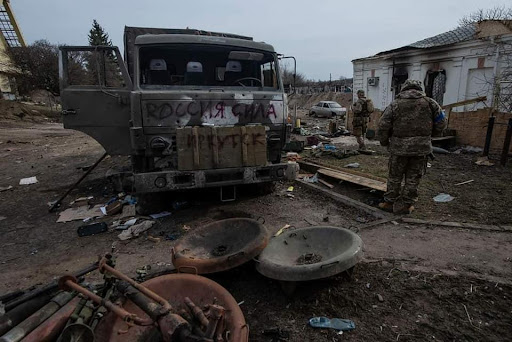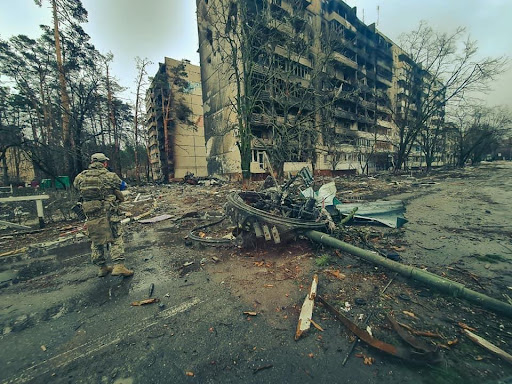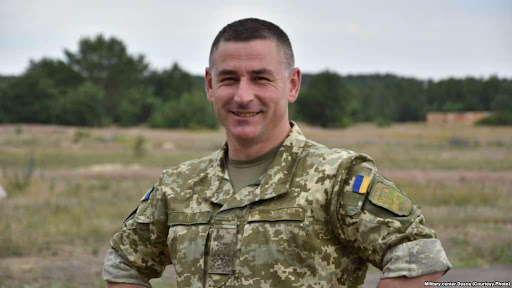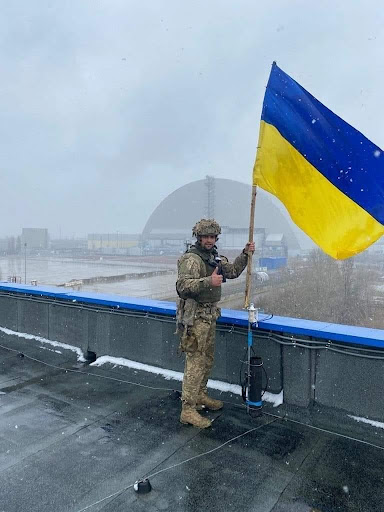
Operation “K” and Putin's Other Adventures
Russia's defeat in the war for the Ukrainian capital is historically significant: the policy of rebuilding the Soviet empire, founded 100 years ago on the same scheme - on the basis of the Russia-Belarus-Ukraine union - has failed
03 April 2022
Russia lost the war for Kyiv. On April 2, 2022, the Ukrainian state regained control over the Kyiv region.
As a result of 38 days of fierce fighting, the Russian army suffered heavy casualties and was forced to retreat after savagely destroying small, quiet, beautiful towns and settlements on the banks of the Dnieper near Kyiv, killing hundreds of civilians. Evidence of their heinous crimes against humanity in Bucha, Irpen and elsewhere is currently being collected and will be submitted to the UN International Court of Justice in The Hague. The bloody actions of the Russian occupiers, which shocked the whole world, also overshadowed the crimes committed by Hitler's fascism in these lands, reminiscent of the Mongol invasion in 1240, which resulted in the destruction of Kyiv and the massacre of its population.
What was the main purpose of the Kyiv operation?
The main task of the Russian Armed Forces, which launched a large-scale attack on Ukraine along all borders on Putin's orders on February 24, was to enter Kyiv, overthrow the legitimate government and thus effectively end the existence of an independent, sovereign Ukrainian state. Russia's military and political leadership is now claiming that they did not intend to seize the Ukrainian capital and other major cities in order to cover up Kyiv's defeat. The main goal was to "liberate" the rest of the Donbas region, which remained under Ukrainian control. But Putin announced the political objectives of the "special operation" in a speech aired on the morning of February 24 - the beginning of intense rocket attacks on Ukrainian cities. He said the goal was to achieve the denazification and demilitarization of Ukraine.
What does denazification mean? Allegedly, there is a Nazi government in Ukraine, which oppresses the people (Russians, Russian-speakers, other ethno-confessional groups) and, moreover, threatens the Russian state, so it is necessary to abolish this system and save Ukraine from Nazi forces and style of thinking. In other words, the goal was to change the government in Ukraine, to establish a puppet regime there, to sign an agreement with this regime that would regulate peace and cooperation between the two countries, and, finally, to include Ukraine in the Russian-Belarusian union. (Lukashenko, Russia's new governor-general of Belarus, has expressed this intention several times in recent months.)
The Treaty on the Establishment of the USSR was signed in December 1922 between the Russian Soviet Federative Socialist Republic, the Ukrainian Soviet Socialist Republic and the Byelorussian Soviet Socialist Republic, as well as the Transcaucasian Soviet Federative Socialist Republic. The Belovezh Accords, which put an end to the USSR, were signed in December 1991 between Russia, Ukraine and Belarus. It is no secret that Putin attaches great importance to symbolism, sacredness, and numerology - just as his intention to restore the empire is no secret. On the 100th anniversary of the founding of the USSR, Putin wanted to reunite the three Eastern Slavic countries. With the creation of the Russia-Ukraine-Belarus union state, Moscow would re-dominate the post-Soviet geography, and whether other republics joined the union would no longer be of fundamental importance. (Many of these countries are connected to Moscow through integrative alliances such as the Eurasian Union and the CSTO. There is a Russian military contingent in Azerbaijan that does not participate in those alliances. Georgia and Moldova, which have chosen the course of European integration, did not take a stand in the event of Ukraine's defeat, and there was no doubt that they would move under the flag of Moscow.)
Let's get back to the point without going too deep.

The direction in which the Russian army is advancing also proves that the main target is Kyiv, it is enough to look at the map to understand this. The Russian command planned and tried to attack the Ukrainian capital from three directions: from Belarus and from the Chernigov and Sumy regions of Ukraine. In the first hours of the attack, a large group entering the territory of Kyiv region entered from the territory of Belarus, and it seems that the Ukrainian command did not expect it. (By the way, this episode should be investigated by the Ukrainian military prosecutor's office and court after the war, as the US and British governments have repeatedly warned the Ukrainian leadership that Russia would attack Kyiv directly from Belarus.) As a result of this gap, the city of Kyiv was suddenly faced with the threat of occupation. There is probably no need to explain what it means to lose the capital during the war.
Until the beginning of March, not only Ukrainians, but all those around the world who supported them and supported Ukraine, had a very exciting and stressful day for the fate of Kyiv. We, the people who support Ukraine in Azerbaijan, put our heads on a pillow every night with the worry of "who will be in control of Kyiv in the morning", and when we woke up in the morning, we excitedly grabbed a smartphone and learned the latest situation. The situation was critical, and enemy reconnaissance and sabotage groups were already operating in the city.
Ukraine's political and military leadership recovered quickly from the first shock and began to take the defense of the capital and the country as a whole seriously. Colonel-General Alexander Sirsky, Commander of the Land Forces, was assigned to lead the defense of Kyiv. Lieutenant General Alexander Pavlyuk, Commander of the Joint Forces in the Donbas, was appointed head of the Kyiv regional administration, and Major General Nikolai Zhirnov was appointed head of the Kyiv city military administration. These generals immediately set up a three-tier defense system around the capital, and later reduced the threat of occupation by conducting effective offensive operations. The Kyiv garrison, no doubt, fought as heroically as the entire Ukrainian army and did not leave the invaders in the heart of the country. There are countless Russian armored vehicles shot down and destroyed around Kyiv, and everyone watching the war has seen numerous videos and photos about it. In particular, the Bucha-Hostomel-Irpen triangle was the scene of relentless clashes, with these cities ranked first among Ukrainian settlements in terms of both the scale of the destruction and the loss of local residents. (After the tormented Mariupol, of course.) Russia's loss of manpower around Kyiv is also quite high, and although we do not have a specific figure, we can safely say that these losses, measured as thousands of dead and wounded.

However, it would be unfair to mention only the city's own garrison as a decisive force in the defense of Kyiv. Injustice against whom? Against the leadership and personnel of the Northern Operational Command of the Land Forces of the Armed Forces of Ukraine. This group of troops created a legendary resistance by taking the first blows of the enemy's battalion-tactical groups consisting of tens of thousands of soldiers and thousands of armored vehicles heading to the capital. Despite the incessant attacks, they did not allow the enemy to enter Kyiv, and were able to defend the territory for which they were responsible, except for non-strategic territorial losses. If Russian forces advancing from Chernigov and Sum had reached the outskirts of Kyiv and joined forces with Belarus, the fate of Kyiv would have been very sad. It is no coincidence that the commander of Major General Victor Nikolyuk, the Northern Operations Command, was awarded the title of "Hero of Ukraine" by President Zelensky.
Transition from maximum plan to minimum plan
Another fact that confirms the existence of a plan to capture Kyiv is that when the Ukrainian army repulsed the attacks and gradually launched a counterattack, expelling the occupiers, parade uniforms belonging to the Russian army were found in a suburban area. The only logical explanation for this finding is that the Russian command intended to organize a military parade in the city after gaining control of Kyiv. (This is also confirmed by official Ukrainian sources.) Such an event, while designed to completely kill the spirit of resistance of the Ukrainian army and people, would demonstrate Putin's triumph to the world.
After realizing the impossibility of capturing Kyiv, the Russian command moved to Plan B and tried to create a siege ring around the city. It was clear that the aim was to keep the city under siege, to prevent the entry and distribution of arms and humanitarian aid sent through Poland to Kyiv, and to force the Zelensky government to sign a surrendering peace. However, they failed to achieve this goal, and by the last week of March, Russian troops were in danger of being besieged. Already, the occupiers had limited supply and logistics capabilities, and the Ukrainian army, in addition to inflicting incessant blows on the enemy with guerrilla methods, exhausted the Russians by targeting its supplies. Everyone remembers the horrible sight of a 64-kilometer convoy of armored vehicles on the narrow road from the Belarusian border to Kyiv. However, this caravan "evaporated" in a short time. Because it was subjected to constant attacks and suffered losses, as well as reduced fuel reserves. That is why Colonel-General Sergei Rudskoi, the First Deputy Chief of Staff of the Russian Armed Forces, said on March 25 that the tasks of the first phase of the operation have been fulfilled and will now focus on the "liberation of the Donbas." Colonel-General Alexander Fomin, Russian Deputy Defense Minister, who attended talks with the Ukrainian delegation in Istanbul on March 29, said they had decided to significantly reduce military activity in Kyiv and Chernigov regions. Allegedly, the goal is to create favorable conditions for the continuation of negotiations and increase mutual trust. It is clear that the reason for the step back was that the troops concentrated around Kyiv failed to fulfill their tasks. Having difficulty in creating a reserve to continue military operations in a wide area, the Russian command decided to withdraw the remaining manpower and military equipment from Kyiv and send them to the eastern front.
In other words, the Russian leadership was forced to abandon the maximum plan (in short, the Belarusianization of Ukraine) to the minimum plan - the complete occupation of the Donbas and the opening of the highway to Crimea. By claiming that this is the main goal since the beginning of the military operation, the Russian leadership can deceive and convince the brainwashed domestic community with its relentless propaganda, but the world knows that this is not the case. If Russia had focused all its efforts on the Donbas from February 24, it could have won by now. However, Putin became a captive of his own hatred, preferring to bury the Ukrainian national state in the most maximalist, most irrational option - attacking along all land and water borders.

In the coming days and weeks, fighting will intensify in eastern Ukraine, where a very bloody and ruthless battle is expected. Russia will try to go to the administrative borders of Donetsk and Luhansk regions, besiege the Ukrainian military group there, declare victory and strengthen its hand in the peace talks, forcing the Ukrainian side to make serious concessions. But regardless of the outcome of the Donbas war, everyone already knows that Putin's Plan A has failed and he has failed to subjugate a free Ukraine.
The new totalitarian empire, the nucleus of which will be formed by the Russian-Belarusian-Ukrainian union state, will remain a dream for Russian imperialism.
The post-Soviet peoples and the entire progressive world are grateful to Ukraine for this.
Translator: Gulnara Rahimova













